Seventies Conduct Hundreds of Mission Tours Worldwide Each Year. What Are They?
Contributed By Scott Taylor, Church News Managing Editor
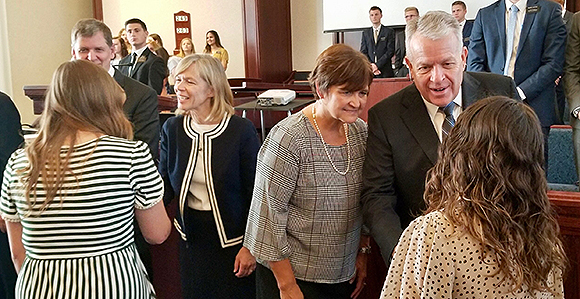
Elder Brent H. Nielson, right, and Sister Marcia Nielson greet a sister missionary, as do Elder James R. Rasband, left, and Sister Mary Rasband prior to a Tennessee Nashville Mission tour session on September 19, 2019, in Brentwood, Tennessee.
Article Highlights
- Each mission of the Church is “toured” or visited each year by a General Authority Seventy.
- The Seventy gets to know the mission, its culture, the mission leadership couple, and the missionaries in a series of meetings.
- The purpose is to bless, strengthen, and edify the mission and learn the mission's needs.
“It’s an opportunity to go and meet the mission president and his wife, to get to know them well, to find out what their needs and concerns are both personally and in the mission, and then spend a lot of time with missionaries, as much as we can.” —Elder Brent H. Nielson, General Authority Seventy
Editor’s note: In late 2019, the Church News followed two General Authority Seventies and their wives on mission tours and interviewed a third before conducting two similar tours. Elder Brent H. Nielson, the executive director of the Missionary Department, toured the Tennessee Nashville Mission, while Elder S. Gifford Nielsen, an assistant executive director in the department, toured the Calgary Canada Mission. Elder Craig C. Christensen, president of the Utah Area, who at times helps conduct mission tours internationally, conducted back-to-back tours in Mexico.
In a public discourse, a General Authority Seventy speaks of an experience while conducting a mission tour. And in a call or email home, a young missionary mentions an upcoming mission tour with a visiting General Authority and his wife.
Mission tour—most Latter-day Saints hear the term and wonder, “What’s that?”
Is a General Authority spending as much time seeing the sights as he is seeing missionaries? Are missionaries loading up in buses to traverse the entire mission and see where their peers work and reside? Or is “mission tour” a euphemism for a General Authority coming to reprimand missionaries or correct mission culture?
No, no, and no.
Surprisingly, the average Church member knows little about the hundreds of these multiple-day mission visits conducted annually. Each mission is “toured” each year, with the Church’s current total of 399 missions worldwide increasing to 407 this summer.
“For a General Authority, it’s an opportunity to go and meet the mission president and his wife, to get to know them well, to find out what their needs and concerns are both personally and in the mission and then spend a lot of time with missionaries, as much as we can,” said Elder Brent H. Nielson, a General Authority Seventy and executive director of the Missionary Department.
Media coverage is common of members of the First Presidency or the Quorum of the Twelve Apostles meeting with entire missions as part of an international ministry, temple dedication or rededication, area review, leadership conference, or other assignment. Those meaningful and impactful mission visits are shorter, generally two hours or so.
Mission tours are conducted by a General Authority Seventy, as assigned by the Office of the President of the Quorum of the Twelve. Rather than a short, single meeting, mission tours are several-day assignments where the presiding authority’s “tour” is really getting to know the mission, its culture, the mission leadership couple and, collectively, the missionaries in a series of meetings held in different locations within the mission boundaries.
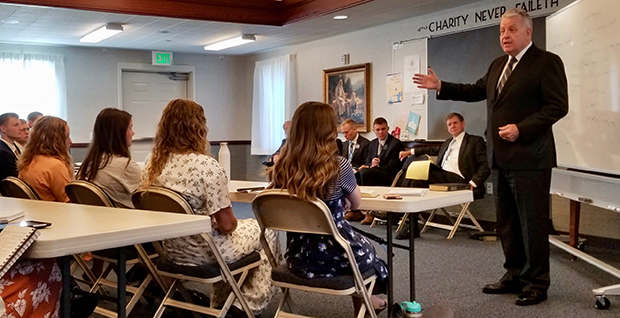
Elder Brent H. Nielson, executive director of the Missionary Department, speaks to the Tennessee Nashville Mission leadership council during a September 19, 2019, mission tour session in Brentwood, Tennessee. Photo by Scott Taylor.
“To really get in and to help, as needed, takes some time, typically a few days; however, we have international missions that are geographically large or complex, which might require more time,” said Elder Craig C. Christensen, a General Authority Seventy and Utah Area President. “It’s really to get to where we can help the mission president and his companion at a level of detail they feel is needed.”
Mission tours include advance planning meetings with the couple missionary leaders, then several daylong series of meetings across the mission area with companionships serving in that region’s zones. The visiting General Authority couple spends plenty of time with the mission leadership couple as they travel from one day’s meetings to another and then on to another. After the daily meetings, the visiting authority usually conducts a review session with the mission president, his companion and, when possible, missionary leaders.
“You have so many topics you can draw from, and it’s up to us as General Authorities to narrow that down—we can only do so many things during the mission tour,” said Elder S. Gifford Nielsen, a General Authority Seventy and one of the Missionary Department’s assistant executive directors. “We meet with the missionaries in the morning and in the afternoon, and we want them to leave the conference feeling uplifted and edified. It’s really important for us to reaffirm to them that we support their mission leaders. Their mission president has been given sacred priesthood keys to lead the world. We want the missionaries believing in miracles, that they can actually do great things.”
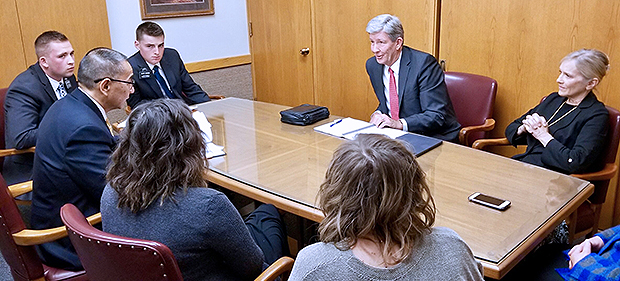
Elder S. Gifford Nielsen, center back, engages with Canada Calgary Mission President Stephen A. Keung, second from left, during an advance planning meeting with the Nielsens, the Keungs, the president’s assistants, and two sister training leaders on October 30, 2019, in Calgary, Alberta, Canada. Photo by Scott Taylor.
Most mission tours outside the United States are conducted by the local area presidencies, composed of three General Authority Seventies. However, some areas—specifically Europe, Mexico, and Brazil—have too many missions within their boundaries for the area presidency to conduct all the annual tours. In those cases, other General Authority Seventies may be assigned to assist—such as Elder Christensen conducting two tours of central Mexico missions in late November.
Elder Nielsen estimates that most General Authority Seventies will conduct three to four mission tours in a year; those in Area Presidencies may average seven to eight tours.

Elder Brent H. Nielson listens to a sister missionary's question during a Tennessee Nashville Mission tour session on September 19, 2019, in Brentwood, Tennessee. Photo by Scott Taylor.
A “Mary and Martha” Experience
Having served as young missionaries in the 1970s in Finland and Chile, respectively, Elder Nielson and Elder Christensen can recall mission visits from General Authorities—but they were shorter sessions and didn’t carry the “mission tour” label.
By the time Elder Christensen was called as a mission president in Mexico City in the mid-1990s and Elder Nielsen was serving as a mission presidency counselor in Houston in the late 1990s, “mission tour” was the title given for the prolonged visits.
Elder Nielson admits no one is quite sure when or how the “mission tour” term started and that maybe it’s one of those Church-vernacular phrases in need of an update or rebranding, since it can create some misperceptions and misunderstandings.
Elder Nielson smiles as he relates his wife’s explanations to friends and family who think “mission tours” equate to being well-traveled. “She’s been to the Louvre in Paris, right on the outside of the gates—she’s never been in,” he said of Sister Marcia Nielson. “She’s been to the Palace of Versailles, right outside. She’s been to some of the most beautiful beaches in Tahiti and never been on them—we’re always in chapels. And then in Nashville recently, we were close to the Grand Ole Opry—and we just went by it.”
Added Sister Nielson: “The reality is that we go on a mission tour to build up the president, his wife and the missionaries. We tour the mission to build faith, encourage good practices, get a feel for the spirit that is there, and to ensure that the president and his wife know how they are loved, supported, valued, and admired. The same for the missionaries—we want to tell them of God’s love for them and of how very much their effort is appreciated.
“Occasionally there are some things that need to be corrected, but that pales in comparison to the love and joy and faithfulness that we become witnesses to as we tour a mission.”
Even a General Authority Seventy getting his first mission tour assignment may not be aware what is in store. “I thought I was going to go into a mission and just tour around and see all the beautiful places in each mission—even though you know you’re always teaching,” said Elder Nielsen.
“But quickly through the Missionary Department I found out that this was a time to meet missionaries and to elevate a mission president and his companion, his wife—the leaders of that mission—in the eyes of the missionaries.”
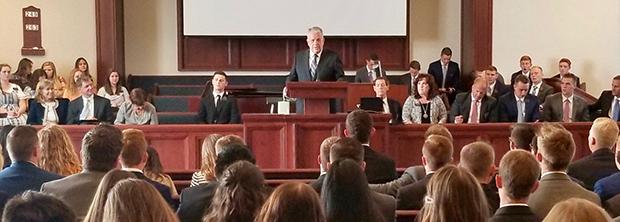
Elder Brent H. Nielson, Missionary Department executive director, speaks during a mission tour meeting with the Tennessee Nashville Mission on September 19, in Brentwood, Tennessee. Photo by Scott Taylor.
President Rhys A. Weaver of the Tennessee Nashville Mission based his preconceived notion on the word “tour.” “I expected a travel itinerary of missionary apartments, churches, vehicles, etc.—go where the missionaries are.”
His companion, Sister Pamela Weaver, had heard mention of mission tours from friends who had led missions, but she didn’t know what to expect. The fact that the Weavers’ first mission tour came less than three months after the start of their service—and that the Missionary Department’s executive director was assigned to preside—had Sister Weaver admittedly “terrified” and “pretty stricken with nervousness.”
With one mission tour already under their belts, President Stephen A. Keung and his companion, Sister Cindy Keung, of the Canada Calgary Mission, looked forward to interacting again with Elder Nielsen and his wife, Sister Wendy Nielsen, whom they had known previously in New Zealand—when Elder Nielsen was in the Pacific Area Presidency and President Keung in the presidency of the New Zealand Missionary Training Center.
“We knew they would come and bless, strengthen, and edify our mission,” Sister Keung said. “This being our second mission tour, I felt we were more knowing—and for me personally, not as nervous.”
President Keung likened a mission tour to the New Testament story of Martha and Mary and the Savior’s visit to them—the former concerned with preparations and serving, the latter with interactions and learning.
He said he anticipated “a lot of work to ensure that all things were in order—that’s the ‘Martha’ side of things, cumbering about. In reality, it was a ‘Mary’ experience—we knew it would be a time of edification, encouragement, and inspired learning.”
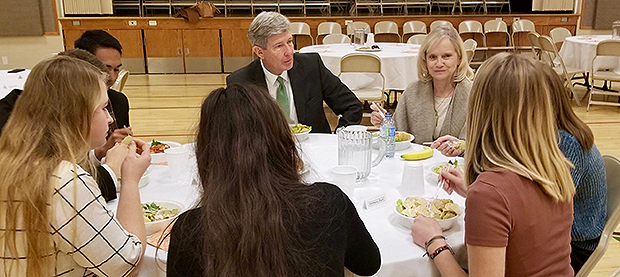
Elder S. Gifford Nielsen and Sister Wendy Nielsen, center back, visit with Canada Calgary Mission missionaries during a midday luncheon October 31, 2019, between mission tour sessions in Calgary, Canada. Photo by Scott Taylor.
A Missionary’s Personal General Conference
Elder Christensen has seen mission tours from both sides—on the receiving end as a mission president a quarter century ago, and then conducting those tours since his call as a General Authority Seventy for the past two decades. And he remembers the impact of an Apostle’s visit while serving as a young missionary in Chile in the mid-1970s.
He sees mission tours having a number of purposes, a primary one being to feel the spirit of the missionaries and to gain a stronger vision of their missionary purpose. “A mission tour is a way where we actually connect and understand what the needs and concerns really are. It’s important for General Authorities to have that kind of detailed understanding.”
Another purpose is to help impact the lives and understandings of the missionaries, just as a young Elder Christensen experienced listening to and learning from a visiting Elder Boyd K. Packer.
“I could still teach what he taught—it has stuck with me,” he recalled. “These are journal moments, monumental moments in the lives of missionaries. Realizing the impact it has on missionaries, we make sure we are doctrinally rich. It’s not like the normal zone conferences. We try and teach what the missionaries teach—but teach it in a very deep, doctrinal way so they can learn personally and internalize the doctrine of Christ. It could change their mission like it changed mine.”
Elder Christensen also emphasized the need to elevate the mission president and his companion in the mission.
“So instead of me standing in front of the missionaries all by myself, there’s about an hour and a half of a four-hour conference meeting where I team-teach with the mission president—the idea being to help the missionaries see their mission president teach and rely on his teaching. I try to make them say, ‘Wow, my mission president really knows what we need to do.’ In that process, you can show how we hope missionaries teach as a companionship. But once again, the goal is to elevate the mission president in the eyes of the missionaries.”
Sister Keung likens a mission tour to another well-known gathering to edify Saints. “It’s our missionaries’ own personal general conference where they are instructed and edified—and receive revelation specific to their call—by one having the power and authority of God,” she said. “I feel like it’s God’s personal gift to His beloved missionaries.”
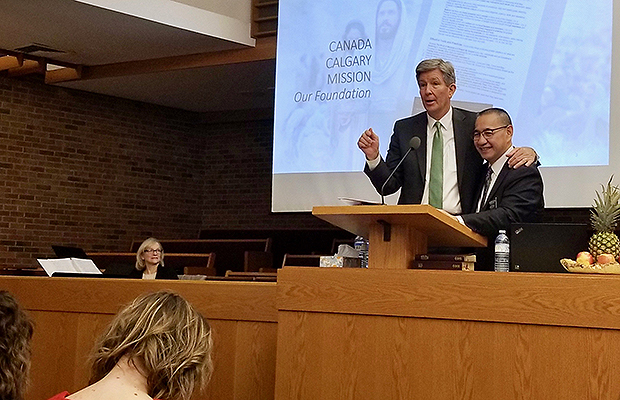
Elder S. Gifford Nielsen joins Canada Calgary Mission President Stephen A. Keung at the pulpit during a mission tour meeting on October 31, 2019, in Calgary, Canada. Photo by Scott Taylor.
A General Authority’s Preparation
There is no set template on how to conduct a mission tour, because missions are different and their needs and opportunities differ as well.
General Authority Seventies who preside over mission tours are given several pages of topics and instruction from the First Presidency and Quorum of the Twelve Apostles that are used not only for mission tours but for the semiannual mission leadership seminars conducted in each Church area.
“We take them and we try to fashion it so it meets the needs of the mission,” Elder Nielson said.
Added Elder Nielsen: “Everything we do in the Missionary Department is the work of apostles and prophets, so we listen very carefully and intently to what President [Russell M.] Nelson is teaching along with the other apostles and prophets.”
That includes Elder Dieter F. Uchtdorf, the member of the Quorum of the Twelve Apostles who is chairman of the Missionary Executive Council, Elder Nielsen said. “Elder Uchtdorf has a unique ability to connect, and his central message in sharing the restored gospel is to do it in normal and natural ways. He is a wonderful example of how to teach.”

Elder S. Gifford Nielsen greets Canada Calgary Mission missionaries prior to a mission tour conference meeting on October 31, 2019, in Calgary, Canada. From left, Sister Cindy Keung of the mission and Sister Wendy Nielsen also welcome missionaries. Photo by Scott Taylor.
In addition to teachings and directives from apostles and prophets, General Authority Seventies and their wives focus intently on teaching in harmony with Preach My Gospel, the standard curriculum for missionaries and mission presidents.
Part of mission tour preparation is reviewing the annual online surveys taken by each missionary. Though the individual identity is kept anonymous, results can be compiled by mission, so the visiting authority can review a mission’s trends in successes and opportunities in a wide range of areas—from familiarity with Preach My Gospel or performance in finding and teaching to keeping missionary standards or following daily routines.
“You see a lot of surveys over time, and they help you realize what the issues are in this specific mission,” Elder Nielson said. “You can see them pretty quickly and you can identify what they are.”
Additional preparation for some conducting mission tours is to give missionaries an assignment in advance—selected scriptures to read, conference talks to review, or a principle to be taught in five minutes if called upon.
Besides reaching out in preliminary conversations for scheduling and coordination with the mission president, a visiting authority may check in with the presidency of the area where the mission is located for additional insights.
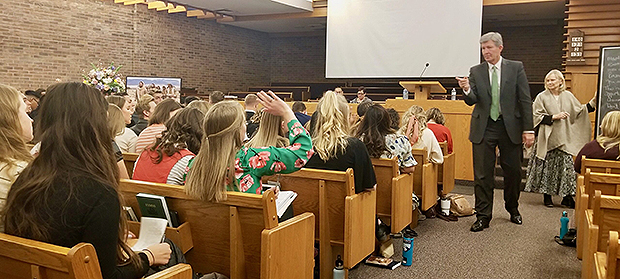
Elder S. Gifford Nielsen and Sister Wendy Nielsen lead a discussion during a Canada Calgary Mission tour conference meeting on October 31, 2019, in Calgary, Canada. Photo by Scott Taylor.
What a Mission Tour Really Looks Like
Before the start of several days of general sessions with missionaries, the visiting authority and wife will typically conduct advance daily meetings with the mission president, his companion, the assistants to the president, and perhaps a companionship of sister training leaders. Others may expand a preliminary meeting to include the entire mission leadership council, consisting of the mission leadership couple, assistants, zone leaders, and sister training leaders.
“We try to find out what their issues are, what things are happening in the mission,” Elder Nielson said.
Then come the daily general sessions with a select part of the missionaries each day, similar to a regular zone conference setting but likely including several zones at a time. Typical of mission tours, a daily schedule will include the visiting authority and wife personally greeting each missionary; morning and afternoon sessions in a meetinghouse chapel with instruction, training, role-plays, Q&As, and testimony; a luncheon between the sessions; and a group photo with the leaders and missionaries sometime before the day is over.
After the conference meetings, the visiting authority may conduct a handful of one-on-one interviews with select missionaries or visit a missionary apartment.

Elder Brent H. Nielson, a General Authority Seventy, interviews a missionary following a Tennessee Nashville Mission tour meeting on September 19, 2019, in Brentwood, Tennessee. Photo by Scott Taylor.
Elder Christensen says his apartment visits are not so much to scrutinize a certain companionship but rather to help the mission leadership couple be mindful of the conditions and circumstances of missionary residences, including settings for study and food preparation. It’s a way to confirm living conditions are comfortable, appropriate, and safe, including the use of carbon monoxide monitors and other safety features.
“And if there is need to make changes in living conditions, then I ask the mission president, ‘Do you know how to solve this? Do you know how to get the resources you need or to upgrade this area of concern?’ And we can guide them down that road—it’s really just a check to make sure they know how to solve any problems they might have.”
Then the General Authority couple and the mission leadership couple rush off to travel for the next day’s sessions, held in a different city. And while some principles and processes may be similar from day to day, the instruction, impressions, and impacts vary daily, even though it is the same mission and the same leaders directing the meetings.
“When you counsel together, you let the Holy Ghost set the agenda of where the discussions go,” said Elder Nielsen, noting the day-to-day differences and the harm of trying to follow a prescribed, identical meeting program. “That sets a bad example because Preach My Gospel is all about feeling the influence of the Holy Ghost. It’s about being able to resolve concerns and understand more deeply the investigators you’re teaching. In essence, what we’re trying to do is model Preach My Gospel.”
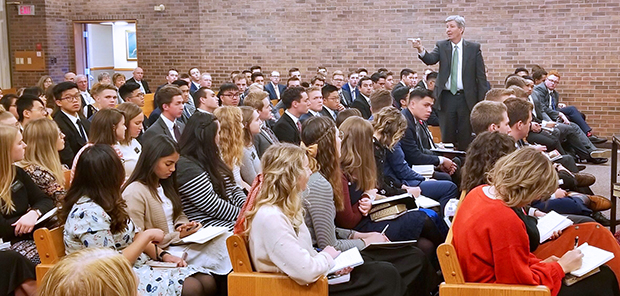
Elder S. Gifford Nielsen engages missionaries in discussion during a Canada Calgary Mission tour meeting on October 31, 2019, in Calgary, Canada. Photo by Scott Taylor.
After two to four days of “touring” the mission and its missionaries, the visiting authority will conduct a concluding review with at least the mission leadership couple and assistants to the president, if not with the entire mission leadership council when possible. They all participate in reviewing what was learned, felt, and experienced.
“The most important part of the tour at the end is to get their feedback and for them to see what happened during the tour—‘what did the Lord teach us during this experience?’” Elder Nielson said. “And sometimes they are not things that were spoken but that they felt needed to happen. … Our hope is that missionaries would feel a renewed desire to take the gospel to the people where they’ve been called.”
Summarized Sister Nielsen: “Mission tours can be taxing in terms of physical, mental, social, and emotional exertion, yet they fill me with spiritual and emotional joy unlike anything else I’ve experienced. I am truly grateful for the opportunity of learning and growing together with missionaries and mission leaders throughout the world.”
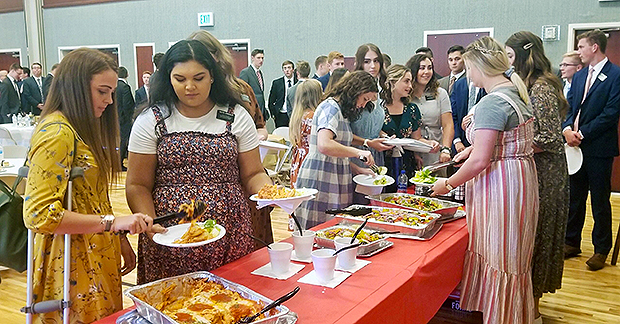
Tennessee Nashville Mission missionaries gather for a midday luncheon between mission tour meetings on September 19, 2019, in Brentwood, Tennessee. Photo by Scott Taylor.

Elder Brent H. Nielson and Elder James R. Rasband, with their wives, join leaders and missionaries of the Tennessee Nashville Mission for a group photo between mission tour meetings on September 19, 2019, in Brentwood, Tennessee. Photo by Scott Taylor.
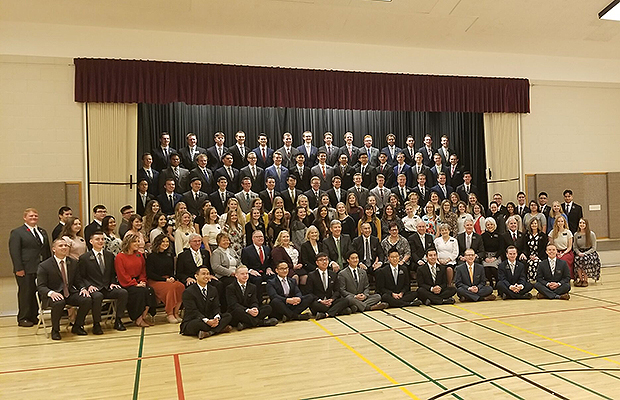
Elder S. Gifford Nielsen and Sister Wendy Nielsen join leaders and missionaries of the Canada Calgary Mission for a group photo at the start of a mission tour meeting on October 31, 2019, in Calgary, Canada.
Photo by Scott Taylor.
